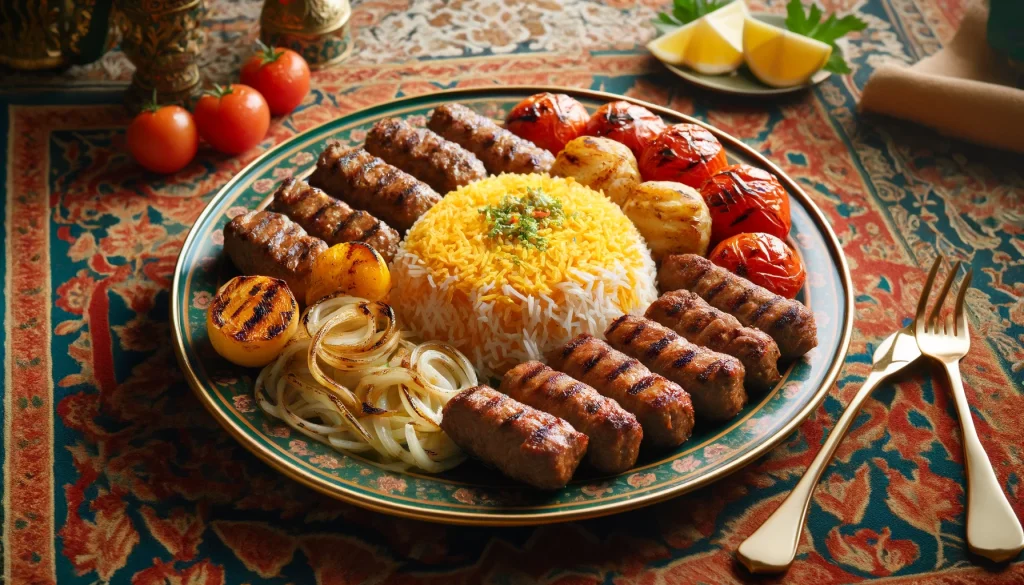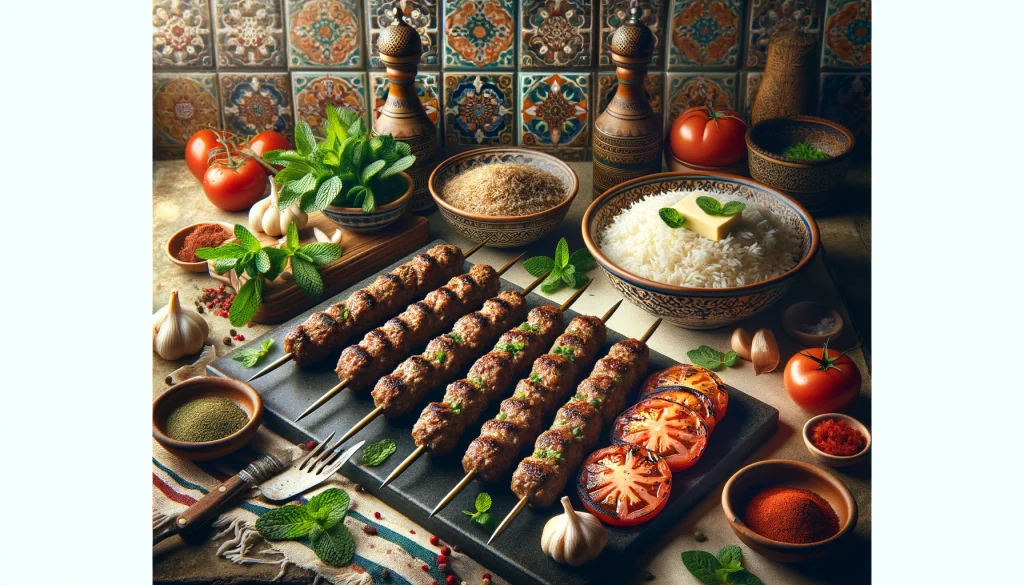As an Amazon Associate I earn from qualifying purchases.
Embark on a culinary journey to the heart of Iran with Chelow Kabab, a dish that is much more than a mere item on a menu – it is a celebration of Persian culture, tradition, and artistry in the kitchen. This iconic dish, beloved across Iran and beyond, perfectly encapsulates the essence of Persian cuisine with its simple yet sophisticated flavors and textures. At its core, Chelow Kabab is a harmonious marriage of two components: Chelow, a meticulously prepared bed of fluffy, aromatic basmati rice, and Kabab, succulent skewers of marinated and expertly grilled meat.
The allure of Chelow Kabab lies in its blend of simplicity and complexity, a characteristic hallmark of Persian culinary philosophy. Every aspect of this dish, from the selection of spices and herbs to the precise grilling technique of the meat, reflects a deep understanding and respect for the ingredients and their inherent flavors. It’s a dish that tells a story – a story of gatherings, feasts, and the warmth of Iranian hospitality.
As we delve deeper into the nuances of Chelow Kabab, we discover not just a recipe, but a culinary ritual that has been passed down through generations, embodying the rich history and gastronomic heritage of Iran. This article will explore the intricate details of Chelow Kabab’s preparation, its variations, and the cultural significance it holds, offering a glimpse into the soul of Persian cooking.
Chelow Kabab

Chelow kabab is a traditional Iranian dish, a staple and one of the most beloved foods in Iranian cuisine. It consists of two key components: ‘chelow’ refers to steamed white rice, often prepared with a golden crust at the bottom, and ‘kabab’ denotes a variety of grilled meats.
The kabab portion often features different types of meat such as minced meat for kabab koobideh, chunks of lamb for kabab barg, or chicken for joojeh kabab. These meats are usually marinated in a mixture of spices, yogurt, and sometimes onions or lemon juice, then grilled over an open fire.
The dish is typically served with the rice and grilled meat together, often accompanied by grilled tomatoes, fresh herbs, and sometimes a raw egg yolk placed on top of the rice. A slice of butter and saffron water may also be poured over the rice to add flavor and aroma.
This dish not only offers a delightful taste experience but also reflects the rich culinary heritage of Iran.
Chelow Kabab Recipe
Chelow kabab, a classic Iranian dish, is known for its aromatic flavors and succulent grilled meats. Here’s a simple recipe to make it at home:
Ingredients
For the Kabab:
- 500g ground lamb or beef (for Kabab Koobideh)
- 1 large onion, grated
- 2 cloves of garlic, minced
- 1 tsp turmeric
- 1 tsp paprika (optional for color)
- Salt and pepper, to taste
For the Chelow (Rice):
- 2 cups basmati rice
- 4 cups water
- Salt, to taste
- 2 tbsp oil
- Optional: Saffron strands soaked in hot water for color and aroma
Optional Garnishes:
- Grilled tomatoes
- Fresh herbs (parsley, coriander, mint)
- Lemon wedges
Instructions
Kabab:
- Mix the Meat: In a bowl, combine the ground meat, grated onion, minced garlic, turmeric, paprika, salt, and pepper. Knead the mixture well for about 5 minutes. This helps the kabab to bind and stay on the skewers.
- Shape the Kabab: Divide the mixture into equal portions. Mold each portion around flat, wide metal skewers to form a long, thin kebab.
- Grill the Kabab: Preheat a grill or broiler. Place the skewers on the grill and cook for about 4-5 minutes on each side or until nicely browned and cooked through.
Chelow:
- Prepare the Rice: Rinse the rice under cold water until the water runs clear. This removes excess starch.
- Boil the Rice: Bring 4 cups of salted water to a boil. Add the rice and boil for 6-8 minutes until it’s parboiled.
- Drain and Steam: Drain the rice and return it to the pot. Add 2 tbsp of oil and arrange the rice in a pyramid shape. This helps it steam evenly.
- Steam the Rice: Cover the pot with a lid wrapped in a clean dish towel (to absorb the steam). Cook on low heat for 30-40 minutes. Optionally, you can sprinkle saffron water on top of the rice for color and flavor.
Serve:
- Presentation: Fluff the rice and serve it on a large platter. Remove the kababs from the skewers and arrange them on top of the rice.
- Garnish: Garnish with grilled tomatoes, fresh herbs, and lemon wedges.
Enjoy your homemade Chelow Kabab with a side of yogurt or a salad for a complete meal! Remember, the key to a great Kabab Koobideh is the kneading of the meat mixture and ensuring the grill is hot enough to cook the meat quickly, sealing in the flavors.
TIPS
Preparing Chelow Kabab, a quintessential Iranian dish, requires attention to detail and a few key techniques to ensure its authentic taste and presentation. Here are some valuable tips:
For the Kabab:
- Quality of Meat: Use high-quality, fatty ground meat (lamb or beef) for juicy and flavorful kababs. The fat content is important as it keeps the kabab moist.
- Kneading the Meat: Thoroughly knead the meat mixture. This not only helps in binding the ingredients but also makes the kababs tender.
- Onion Juice: When adding grated onion, squeeze out the excess juice. This juice can make the mixture too wet and prevent the kababs from holding onto the skewers.
- Uniform Thickness: Ensure that the kabab is uniformly wrapped around the skewer. Uneven thickness can lead to uneven cooking.
- Grilling Technique: If using an outdoor grill, make sure it is very hot before cooking the kababs. This sears the meat quickly, locking in flavors and juices.
- Turning the Kababs: Turn the kababs frequently for even cooking and to prevent them from burning.
For the Chelow (Rice):
- Rice Quality: Use high-quality basmati rice for its fragrance and long, fluffy grains.
- Rinsing and Soaking: Rinse the rice several times until the water runs clear to remove excess starch. Soaking the rice for 30 minutes to an hour can also help in achieving fluffier grains.
- Water Ratio: Be mindful of the water-to-rice ratio. Typically, it’s about twice the amount of water to rice.
- Creating the Tadig: For the golden crust at the bottom (tadig), you can add thinly sliced potatoes, bread, or simply let the rice itself create the crust.
- Low and Slow Cooking: Cook the rice on a low heat to allow it to steam properly. This results in perfectly cooked, separate grains.
- Saffron: Use a pinch of saffron soaked in hot water to add both color and a luxurious aroma to the rice.
Serving and Presentation:
- Garnishes: Serve with grilled tomatoes, raw onions, fresh herbs, sumac, and lemon wedges. These add freshness and a nice acidic balance to the rich meats.
- Butter and Egg Yolk: In some traditional settings, a raw egg yolk and a piece of butter are placed on top of the rice just before serving, adding richness.
- Layering: You can layer the rice with barberries (zereshk), nuts, or other dried fruits for added texture and flavor.
Miscellaneous:
- Resting the Meat: Allow the meat to rest after kneading and before shaping it onto the skewers. This helps in better binding.
- Use of Skewers: If you don’t have traditional flat skewers, you can shape the kababs and cook them directly on the grill, though this requires more careful handling to prevent breaking.
Remember, the key to a perfect Chelow Kabab lies in the balance of flavors and textures – the aromatic, fluffy rice combined with the rich, succulent meat. Take your time to savor the process and the result will be a delicious, authentic dish!
Why This Recipe Is Just So Good…

The excellence of the Chelow Kabab recipe lies in its harmonious blend of simple yet high-quality ingredients, the meticulous cooking techniques, and the rich cultural heritage it embodies. Here are some reasons why this dish stands out:
- Balance of Flavors and Textures: The combination of tender, spiced kababs with the fluffy, aromatic basmati rice creates a delightful contrast. The kababs are juicy and flavorful, often with a hint of smokiness from the grill, while the rice provides a neutral, yet fragrant, base for the meat.
- Quality of Ingredients: Using high-quality, fresh ingredients plays a crucial role. The choice of meat, the aromatic basmati rice, and the freshness of the herbs and spices all contribute to the overall taste.
- Complexity in Simplicity: Despite its apparent simplicity, Chelow Kabab requires precision in its preparation. The way the meat is kneaded, the rice is cooked, and the dish is assembled demands a certain level of culinary skill, making the process almost an art form.
- Culinary Tradition: This dish is steeped in Iranian culinary tradition. It’s not just food; it’s a representation of the culture, history, and pride of Iranian cuisine. This cultural richness adds an intangible flavor to the dish.
- Variety and Customization: The basic recipe allows for variations. Whether it’s the type of kabab (Koobideh, Barg, Joojeh, etc.) or additions to the rice (like saffron, barberries, or nuts), there’s room for customization while still maintaining the essence of the dish.
- Social and Festive Aspect: Chelow Kabab is often associated with gatherings, celebrations, and hospitality in Iranian culture. The joy and warmth of these occasions can enhance the dining experience.
- Nutritional Balance: The dish provides a good balance of carbohydrates (rice), protein (meat), and fats, along with the potential addition of vitamins and minerals if served with herbs and vegetables.
- Aromatic Spices and Herbs: The use of spices like turmeric and the garnish of fresh herbs add layers of flavor and aroma, making the dish more appetizing and rich in taste.
- Sensory Experience: The combination of sight (the beautifully arranged platter), smell (the aromatic rice and grilled meat), and taste (the perfectly seasoned kabab and rice) makes eating Chelow Kabab a full sensory experience.
- The Joy of Grilling: The process of grilling the kababs itself is enjoyable and interactive, often bringing people together in the preparation of the meal.
In essence, Chelow Kabab is not just about the taste; it’s about the experience, tradition, and the love that goes into preparing it, making it a dish that’s cherished by many.
Storage Instructions
Storing Chelow Kabab properly is crucial for maintaining its taste and ensuring it remains safe to eat. Here are some guidelines for storing both the rice (Chelow) and the kababs:
Refrigerating:
- Cool Down First: Allow the Chelow and kababs to cool to room temperature before storing. Hot food can raise the temperature inside the refrigerator, leading to bacterial growth.
- Separate Containers: Store the rice and kababs in separate airtight containers. This prevents the rice from absorbing any excess moisture from the kababs, which can make it soggy.
- Refrigerator Duration: Properly stored, the kababs and rice can last in the refrigerator for 3-4 days.
Freezing:
- Freezer-Safe Containers or Bags: Use freezer-safe containers or ziplock bags for storing. Make sure to remove as much air as possible from the bags.
- Freezing Kababs: Kababs can be frozen either cooked or uncooked. For cooked kababs, make sure they are completely cooled before freezing. For uncooked kababs, you might freeze them on their skewers, or as patties if skewers are not practical.
- Freezing Rice: It’s best to freeze rice as soon as possible after cooking. Spread it on a baking sheet to cool quickly, then transfer to airtight containers.
- Freezer Duration: In the freezer, the kababs and rice can last for up to 2-3 months. However, for optimal taste, it’s best to consume them within a month.
Reheating:
- Thawing: Thaw frozen kababs and rice in the refrigerator overnight. Avoid thawing at room temperature as it can lead to bacterial growth.
- Reheating Rice: Reheat the rice in a microwave, covered, with a few tablespoons of water added to help rehydrate it. Alternatively, reheat it in a saucepan over low heat with a bit of added water or butter.
- Reheating Kababs: Kababs can be reheated in a microwave, oven, or on a stovetop. In the oven, cover them with foil to prevent drying out. On the stovetop, a quick sear in a pan can help restore some of the grilled flavors.
General Tips:
- Label and Date: Always label your containers with the date of storage. This helps in tracking how long they have been stored and avoids the risk of consuming old food.
- Avoid Repeated Reheating: Reheat only the amount of food you plan to consume. Repeated reheating can degrade the quality of the food and increase the risk of foodborne illness.
- Check for Spoilage: Before consuming leftovers, always check for any signs of spoilage, like a bad smell or mold.
Proper storage not only extends the shelf life of Chelow Kabab but also helps in retaining its flavors and textures when you’re ready to enjoy it again.
Frequently Asked Questions (FAQ)

Here are some expert-level questions and answers about Chelow Kabab, delving deeper into its preparation, variations, and cultural significance:
Q: What is Chelow Kabab?
A: Chelow Kabab is a popular Persian dish consisting of two main components: ‘Chelow,’ steamed saffron-flavored basmati rice, and ‘Kabab,’ grilled skewered meats. It’s a staple in Iranian cuisine, known for its aromatic rice and flavorful, tender meat.
Q: What types of meat are used for the kabab?
A: The most common meats used are lamb, beef, and chicken. The specific type depends on the kabab variant, like ground meat for Kabab Koobideh, thinly sliced meat for Kabab Barg, and chunks of chicken for Joojeh Kabab.
Q: How do you make the rice for Chelow Kabab?
A: The rice is washed and sometimes soaked, then parboiled. After draining, it’s steamed with a bit of oil, and often saffron, to create a fluffy, aromatic dish. A distinctive feature is the crispy bottom layer of rice, known as ‘tadig.’
Q: How long should the kabab be cooked?
A: The cooking time varies depending on the type of kabab and the heat of the grill. Generally, it takes about 4-5 minutes on each side for the kababs to cook through and get a nice char on the outside.
Q: Can Chelow Kabab be made in advance?
A: Yes, you can prepare Chelow Kabab in advance. The rice and kababs can be refrigerated and reheated, though they taste best when freshly made. The kababs can also be marinated and stored in the fridge overnight before grilling.
Q: Is Chelow Kabab suitable for vegetarians?
A: Traditionally, Chelow Kabab is not vegetarian since it includes meat. However, vegetarian variants can be made using grilled vegetables or plant-based meat substitutes.
Q: What are the common garnishes or sides served with Chelow Kabab?
A: It’s typically served with grilled tomatoes, raw onions, fresh herbs, lemon wedges, and sometimes a side of yogurt or a salad. These add freshness and a nice acidic balance to the rich flavors of the meat and rice.
Q: How can I store and reheat leftovers?
A: Leftover Chelow and kababs can be stored in separate airtight containers in the refrigerator for 3-4 days. Reheat the rice with a bit of water to retain moisture, and the kababs can be reheated in a microwave, oven, or on a stovetop.
Q: Can I make Chelow Kabab without a grill?
A: Yes, you can cook the kababs in an oven broiler or on a stovetop griddle or pan. The key is to achieve a high enough heat for a good sear on the meat.
Q: How do I prevent the kababs from falling off the skewers?
A: Ensure the meat mixture is well-kneaded and not too wet, press it firmly onto the skewers, and use wide, flat skewers if possible. Chilling the skewered kababs before grilling can also help them hold together better.
Q: What are the key factors that affect the texture and flavor of the kabab in Chelow Kabab?
A:
Meat Quality: The fat content and the freshness of the meat play a crucial role. Traditionally, a mixture of lean meat and fat (like lamb or beef with a bit of fat) is used for a juicy, flavorful kabab.
Marination: Ingredients in the marinade, such as onions, garlic, and spices, significantly affect the flavor. The duration of marination can also impact the tenderness of the meat.
Grinding and Kneading: The texture of the kabab is affected by how finely the meat is ground and how well it’s kneaded. A good kneading technique can make the kabab tender and help it bind better to the skewer.
Cooking Method: The high heat of the grill or broiler ensures a smoky flavor and a charred exterior while keeping the inside moist.
Q: How does the preparation of Chelow differ from ordinary steamed rice?
A:
Rinsing and Soaking: Chelow requires thorough rinsing and often soaking, which is not always necessary for ordinary steamed rice. This process ensures the grains are less sticky and more fragrant.
Parboiling and Steaming: Chelow involves parboiling the rice followed by a steaming process, which is different from the single-step cooking of regular steamed rice.
Tadig Formation: A distinctive feature of Chelow is the creation of ‘Tadig’ – the crispy golden crust at the bottom of the pot, achieved by cooking the rice on low heat for an extended period.
Q: What are some common variations of kabab served with Chelow?
A:
Kabab Koobideh: Ground meat (usually lamb or beef) mixed with spices and onions, shaped around flat skewers.
Kabab Barg: Thinly sliced pieces of lamb or beef, marinated and grilled.
Joojeh Kabab: Marinated chunks of chicken, often with a saffron-based marinade.
Kabab Bakhtiari: A combination of Joojeh (chicken) and Barg (lamb/beef) kababs on the same skewer.
Q: What is the cultural significance of Chelow Kabab in Iranian cuisine?
A:
Chelow Kabab is more than just a dish; it’s a part of Iran’s culinary identity. It’s often served during celebrations, gatherings, and is a symbol of hospitality.
The dish reflects the history and geography of Iran, showcasing the influence of spices, cooking methods, and the importance of rice and meat in Persian cuisine.
Q: Are there any specific health considerations related to Chelow Kabab?
A:
Nutritional Balance: While it offers a good balance of protein (from the meat) and carbohydrates (from the rice), the dish can be high in fat, especially if made with fatty cuts of meat.
Portion Control: Like any rich dish, moderation is key. Overindulgence can lead to excessive calorie intake.
Use of Fresh Ingredients: Using fresh, unprocessed ingredients ensures the meal is free from unnecessary additives and preservatives, making it healthier.
Q: How can one ensure that the kabab stays on the skewer during grilling?
A:
Proper Kneading: Thoroughly knead the meat mixture to ensure it binds well.
Moisture Content: The mixture should not be too wet. Squeeze out excess juice from grated onions.
Skewer Technique: Use wide, flat skewers and press the meat firmly onto the skewer.
Chill Before Grilling: Chilling the skewered kababs in the refrigerator for a short time can help them firm up and stick better.
These expert-level insights delve into the nuances of Chelow Kabab, highlighting its preparation intricacies, cultural importance, and variations.
Conclusion
In conclusion, Chelow Kabab is not just a dish; it’s a vibrant tapestry woven with the threads of history, culture, and culinary artistry. This quintessential Persian delicacy transcends the boundaries of mere sustenance, embodying the spirit of Iranian hospitality and the richness of its culinary heritage. As we have seen, each component of Chelow Kabab, from the aromatic saffron-infused rice to the succulent, grilled meats, is prepared with a level of care and precision that speaks to the deep-rooted traditions of Persian cooking.
The dish’s enduring popularity and its celebrated status in Iranian cuisine are testaments to its timeless appeal and the universal joy of sharing a hearty, flavorful meal. Whether served in a humble home kitchen or a lavish restaurant, Chelow Kabab brings people together, creating moments of connection and joy over a shared love for good food.
As we bid farewell to the world of Chelow Kabab, we take with us not only the knowledge of its preparation but also an appreciation for the cultural richness it represents. This journey into the heart of Persian cuisine reveals that food is more than just nourishment; it is a language of love, a symbol of heritage, and a bridge that connects us across cultures and generations. Chelow Kabab, in all its delectable simplicity, is a perfect ambassador of this universal truth.






